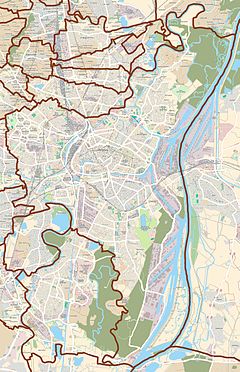| Hôtel des Deux-Ponts | |
|---|---|
 Façade and garden on Place Broglie Façade and garden on Place Broglie | |
 | |
| Former names | Hôtel de Gayot |
| Alternative names | Hôtel du gouverneur militaire |
| General information | |
| Type | Civic |
| Architectural style | Baroque |
| Location | Strasbourg, France |
| Coordinates | 48°35′06″N 7°45′06″E / 48.58500°N 7.75167°E / 48.58500; 7.75167 |
| Current tenants | French Armed Forces |
| Construction started | 1754 |
| Completed | 1755 |
| Design and construction | |
| Architect(s) | Joseph Massol, Georges Michel Muller |
The Hôtel des Deux-Ponts, formerly known as the Hôtel Gayot and currently as the Hôtel du gouverneur militaire, is a historic building located on Place Broglie on the Grande Île in the city center of Strasbourg, in the French department of the Bas-Rhin. It has been classified as a Monument historique since 1921.
The Hôtel des Deux-Ponts is currently used as the official residence of the military governor of Strasbourg.
History
The Hôtel was designed as a hôtel particulier for the brothers, royal moneylenders François-Marie Gayot and Félix-Anne Gayot and built in 1754-55 featuring a courtyard, two ornate façades, a grand portal and a French garden. In 1770, it was sold by François-Marie Gayot to count palatine Christian IV of Zweibrücken (German: zwei Brücken = English: two bridges = French: deux ponts). Maximilian Joseph of Zweibrücken-Birkenfeld, the future King Maximilian I of Bavaria lived there from 1770 until 1790. His son and successor on the Bavarian throne, Ludwig I of Bavaria, was born in this palace on 25 August 1786.
The hôtel became state-owned (bien public) in the wake of the French Revolution in 1791 and has served as the official residence for military governors and chiefs of staff since, including during the periods when Strasbourg was a German town again (1871–1918 and 1940–1944). It is not open for tourists apart on special days such as European Heritage Days.
Gallery
-
 Panoramic view through the garden on Place Broglie
Panoramic view through the garden on Place Broglie
-
 Plaque for Maximilian I Joseph of Bavaria
Plaque for Maximilian I Joseph of Bavaria
-
 Main portal on Rue brûlée. The courtyard right behind is rarely seen.
Main portal on Rue brûlée. The courtyard right behind is rarely seen.
-
 Lower part of entrance hall
Lower part of entrance hall
-
 Ceiling of entrance hall with a fresco by Joseph Melling (1785)
Ceiling of entrance hall with a fresco by Joseph Melling (1785)
-
 A working and reception room
A working and reception room
References
- Base Mérimée: Hôtel des Deux Ponts ou Hôtel du Gouverneur militaire, Ministère français de la Culture. (in French)
External links
 Media related to Hôtel des Deux-Ponts at Wikimedia Commons
Media related to Hôtel des Deux-Ponts at Wikimedia Commons- Hôtel du gouverneur militaire - place Broglie Archived 2016-03-04 at the Wayback Machine on archi-wiki.org (in French)
Literature
- Recht, Roland; Foessel, Georges; Klein, Jean-Pierre: Connaître Strasbourg, 1988, ISBN 2-7032-0185-0, pages 119–120